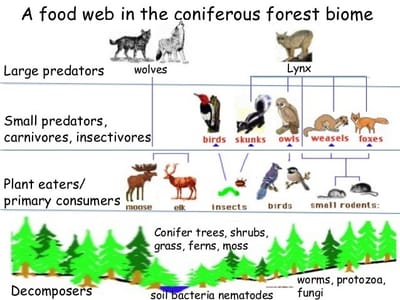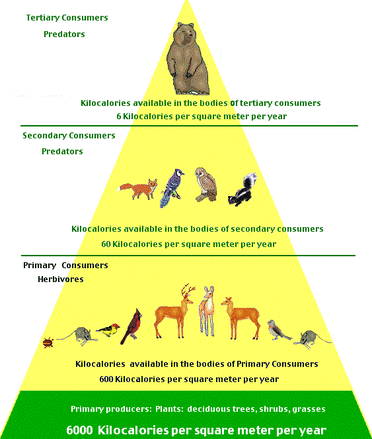Coniferous Forest
Climate Info
Limiting Factors and Adaptation
Limiting Factors
As the population increases so does the density dependent factors such as the amount of predation and competition. The independent factors affect the population the same regardless of size. This includes natural disasters such as wild fires and droughts.
Learn MoreAnimal Adaptations
Snowshoe hares prefer to live in dense coniferous forests, and these mammals have developed a unique adaptation: the changing of their fur color from season to season. During the warmer months, snowshoe hares have brown fur that camouflages them within the dead leaves and branches of the forest floor. Wolverines are tenacious predators but will also eat plants and berries in the summer months. They have also been known to drag away carrion for consumption, such as a caribou head or carcass. Wolverines sometimes use downed coniferous trees for stashing food and building dens. Lastly, wood frogs spend the cold months completely dormant. In fact, these frogs get so cold that nearly 75 percent of their body can turn into ice, and the frog will still emerge during the spring thaw, ready to resume normal activities.
Learn MorePlant Adaptations
Typical trees include spruce, pine and fir. Coniferous trees have thick bark to protect against the cold. They are cone-shaped, with flexible branches which help them to cope with heavy snow fall. Pine cones protect the seeds during the harsh winter. Their evergreen nature means that the needles can photosynthesise whenever there is sufficient sunlight. The dense forest creates warmth during the harsh winter.
Learn MoreFood Web and Energy Pyramid


Human Impact

Carbon and Nitrogen Cycle
Carbon Cycle
The carbon cycle is actually a big necessity in the taiga biome because of the large vegetation species. The Carbon cycle creates a steady amount of carbon available in the environment, helping plants when ever photosynthesis is being occurred. Without the Carbon cycle, plants wont be able to perform photosynthesis which is a big necessity for the environment and all of the different species living there who need oxygen to survive.
Learn MoreNitrogen Cycle
The nitrogen cycle helps this biome actually convert all the non usable nitrates into usable ones that the plants can actually use themselves. If the nitrogen cycle wasn't available, over time all those nitrates would overflow causing effects to all the plants and animals living there.
Learn MoreSources
https://www.eartheclipse.com/ecosystem/coniferous-forest-biome.html https://sciencing.com/animals-adaptations-coniferous-forest-8446490.html https://www.bbc.co.uk/bitesize/guides/zy74ycw/revision/2 https://boandseth.weebly.com/human-impacts.html https://taigaconiferous.weebly.com/nutrient-cycles.html
Learn More


